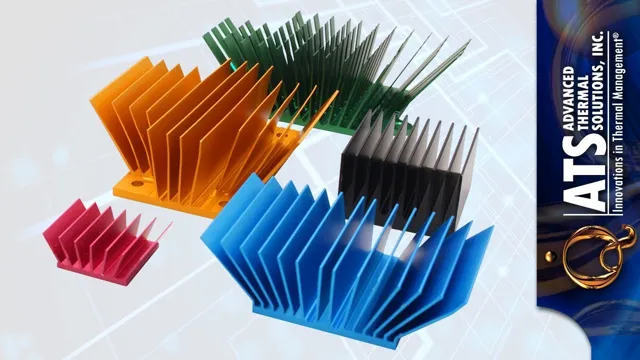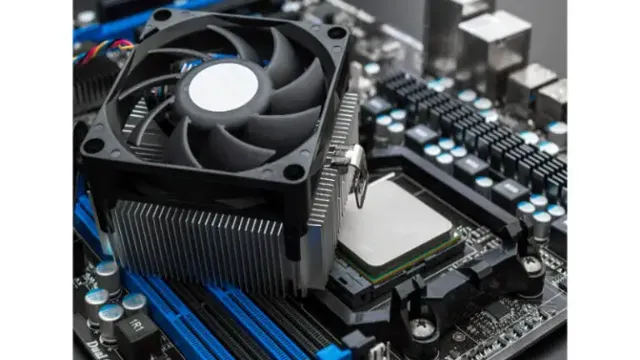Have you ever wondered how your computer stays cool even when you’re running multiple programs at the same time? Well, the answer lies in a small but mighty component called a heatsink. This humble device may not look like much, but it plays a vital role in ensuring that your computer’s processor doesn’t overheat and get damaged. Think of a heatsink as a sort of radiator, but for your computer instead of your car.
It helps to dissipate heat away from your CPU and keep it running smoothly even under heavy loads. Without a heatsink, your computer’s performance would suffer, and you could even risk damaging your hardware. So, let’s take a closer look at this unsung hero of the computing world and see how it works.
How Heat Affects Devices
Do you ever wonder how devices manage to stay cool while in use? The answer lies in a small but mighty component called a heatsink. A heatsink is essentially a passive cooling system that absorbs and dissipates heat away from a device’s processing components. As devices work harder and generate more heat, a heatsink ensures that the internal temperature remains at a safe level.
Without a heatsink, devices can overheat and potentially become damaged or even fail altogether. So next time you hear the term “heatsink”, remember that it’s a crucial component that helps keep your devices functioning properly and safely.
Understanding Thermal Management
Thermal management is a vital aspect of any device’s longevity. Heat can have serious effects on electronic devices, from causing gradual degradation in performance to sudden shutdowns or malfunctions. Therefore, managing heat is crucial in ensuring that devices perform optimally and avoid premature failures.
When a device operates, it generates heat, and if there is no proper system in place to dissipate the heat, it will accumulate and affect the device’s performance and lifespan. Similar to how we use air conditioning or fans to keep ourselves cool during hot days, we need to have appropriate cooling systems in our devices to ensure they do not overheat. By doing so, we can extend the lifespan of our devices, minimize repair costs, and avoid data loss.
It is essential to understand the effects of heat on devices and ensure all devices have optimal thermal management systems.

The Role of Heatsinks in Cooling
Heatsinks play a vital role in keeping electronic devices cool. But why is this even necessary? Well, devices generate heat when electricity passes through them. This heat can become a major problem and potentially damage the device if it’s not dissipated efficiently.
Devices such as CPUs and GPUs are especially prone to overheating due to their high power consumption. This is where heatsinks come in. A heatsink is designed to dissipate heat by increasing the surface area of a device, enabling the heat to spread out and cool down.
Think of it as a radiator for your car, but instead of water, it’s dissipating heat. The more surface area a heatsink has, the more efficient it will be at dissipating heat. Additionally, heatsinks are often paired with fans to blow air over them, which increases their cooling capabilities even further.
With the rise of high-performance devices, heatsinks have become an increasingly important component in keeping our electronics running smoothly.
Types of Heatsinks
If you’re into computer hardware or electronics, you’ve likely heard of a heatsink. But what does a heatsink actually do? In short, a heatsink is a component that helps dissipate heat from a hot component like a microprocessor or a voltage regulator. It works by utilizing fins or other conductive surfaces that increase the surface area of the component, allowing more heat to dissipate into the surrounding environment.
There are several types of heatsinks, including passive, active, and water-cooled. Passive heatsinks rely solely on convection to dissipate heat, while active heatsinks use a fan to increase airflow. Water-cooled heatsinks are often used in high-performance systems and involve circulating water to remove heat from the component.
Ultimately, what type of heatsink you use will depend on your individual needs and budget. However, one thing is for sure: a properly functioning heatsink is essential for keeping your electronics running smoothly and preventing damage from overheating.
Active vs. Passive Cooling
Types of Heatsinks Heatsinks are an essential part of any electronic device’s cooling system. They are responsible for dissipating excess heat produced by the device to prevent damage and increase its longevity. Heatsinks come in two types: passive and active.
Passive heatsinks work by using natural convection to dissipate heat, while active heatsinks use fans and other cooling systems to enhance heat dissipation. The most common types of heatsinks are the passive air-cooled heatsink and the active liquid-cooled heatsink. Passive air-cooled heatsinks are the simplest and most widely used, while active liquid-cooled heatsinks are more complex and used in high-performance applications.
Overall, heatsinks play a vital role in keeping electronics cool and extending their lifespan.
Choosing the Right Heatsink for Your Device
When it comes to choosing the right heatsink for your device, there are several types to consider depending on your specific needs. One popular option is the finned heatsink, which features a series of fins that increase the surface area for better heat dissipation. Another option is the liquid cool heatsink, which uses a liquid coolant to efficiently transfer heat away from the device.
Heat pipe heatsinks also utilize liquid cooling technology, but they use a specially designed heat pipe to transfer heat to the fins. For smaller devices with limited space, a compact vapor chamber heatsink may be the best choice as it uses a specially designed metal plate to efficiently transfer heat through its walls. Ultimately, the type of heatsink that you choose will depend on a variety of factors, including your device’s size, power output, and operating environment.
By choosing the right heatsink for your device, you can ensure optimal performance and longevity.
Common Materials for Heatsinks
Heatsinks are a crucial component in managing heat produced by electronic devices. One of the most common types of heatsinks is the passive heatsink, which relies on natural convection to dissipate heat. These heatsinks are typically made of aluminum or copper due to their high thermal conductivity and low cost.
Aluminum is a popular choice for larger heatsinks as it is lightweight and has good thermal properties. Copper, on the other hand, is preferred for smaller heatsinks due to its better thermal conductivity. Other materials used for heatsinks include graphite, which is known for its ability to conduct heat in the lateral direction, and ceramics such as silicon carbide, which has excellent thermal shock resistance and high temperature stability.
Some heatsinks are also made of composite materials, like aluminum with embedded heat pipe technology, which further enhances heat dissipation. Depending on the application and size constraints, different materials can be used to create an effective heatsink that ensures optimal performance and longevity of electronic devices.
Benefits of Using a Heatsink
If you’ve ever used a computer or electronic device, you may have heard of a heatsink. A heatsink is a crucial component that helps keep devices cool by dissipating heat. The heatsink is typically made of metal and often features fins or other designs that help increase its surface area.
When a device generates heat, the heatsink absorbs that heat and spreads it across its surface. This allows the heat to dissipate into the surrounding air, preventing the device from overheating and potentially damaging vital internal components. Whether you’re using a laptop, a gaming console, or a home theater system, incorporating a heatsink can help ensure that your device remains cool and functions optimally.
So, if you’re wondering what does heatsink do, the answer is simple – they keep your electronics cool and safe from potential damage.
Improving Device Performance and Lifespan
Heatsink If you’ve ever wondered how to improve the performance and lifespan of your device, then using a heatsink may be your answer. Heatsinks are designed to dissipate heat away from your device, preventing overheating and component failure. Overheating can cause electronic components to fail, shortening the lifespan of your device.
A heatsink is a cost-effective way to improve longevity and reduce the chances of damage caused by excessive heat. The benefits of using a heatsink are evident in high-performance devices such as gaming computers, laptops, and routers that are often prone to overheating. A heatsink is made of a dense material with fins or pins that create a larger surface area for heat to escape, thus increasing the cooling efficiency.
Using a heatsink can not only improve device performance but also prevent costly repairs and replacements resulting from heat damage. So next time you want to prolong the lifespan of your device, consider using a heatsink for optimal performance.
Reducing the Risk of Overheating and Damage
Heatsink When it comes to managing the heat generated by your devices, a heatsink can be extremely beneficial in reducing the risk of overheating and damage. A heatsink works by primarily transferring heat away from the device and dispersing it through the heat sink’s fins, where it can then be dissipated into the surrounding air. By using a heatsink, you can effectively reduce the temperature of your device and prevent it from overheating, which can not only lead to damage but also to potentially dangerous situations.
Additionally, heatsinks can improve the overall performance of your device by ensuring that it operates at an optimal temperature. So if you’re looking to protect your devices from overheating, a heatsink is definitely worth considering.
Conclusion: Importance of Thermal Management
In conclusion, a heatsink is like a superhero for your electronic devices, fighting against the villainous heat that can damage and impair their performance. With its thermal conduction powers, it absorbs and dissipates the excess heat generated by your device’s components, keeping them cool and running smoothly. So, the next time you thank your lucky stars for your gadget’s endurance and efficiency, remember to give a nod to the humble heatsink, the unsung hero who saved the day!”
FAQs
What is a heatsink?
A heatsink is a component used in electronic devices to dissipate heat and prevent overheating.
Why do electronic devices need heatsinks?
Electronic devices generate heat during their normal operation and if not properly dissipated, can cause damage or shorten the device’s lifespan. Heatsinks help to move that heat away from critical components.
How does a heatsink work?
A heatsink works by providing a larger surface area for heat to dissipate into the surrounding air, removing the heat from the device and preventing it from accumulating.
Can a device overheat if it doesn’t have a heatsink?
Yes, electronic devices without proper cooling mechanisms, like heatsinks, can overheat and potentially cause damage or failure to the device.
